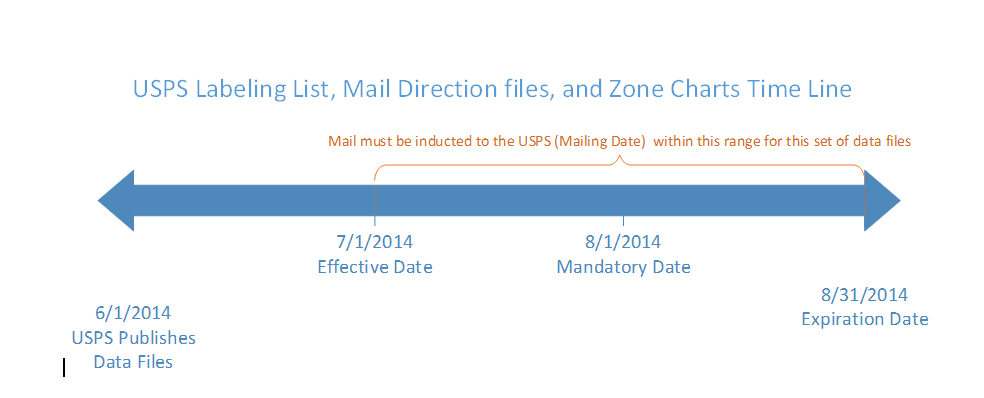Mailers claiming workshare discounts should be aware of an upcoming change to how the USPS® publishes their Labeling List, Mail Direction, and Zone Chart data. On June 1, 2014, these data files, which have previously been distributed on a quarterly basis, will be distributed monthly. Mailers will need to ensure that these data files are valid at the time of the mailing (mail induction) or risk acceptance issues. Software and education can help simplify the adjustment to rapid-fire monthly updates.
Before ensuring the validity of these data files, mailers should know what these files do and how are they used. In general, the three sets of data files give software the ability to sort mail and generate workshare discounts based on the mail piece groupings, drop locations, and zones. Below is a more detailed description of each of the data file groups.
· Labeling Lists are a set of files that define the current 3- and 5-Digit ZIP Code schemes needed to correctly sort mail to bundles, trays, and containers. The Labeling Lists also provide the destination city, state, and ZIP Code that must be printed on the bundle, tray, or container label. In other words, the Labeling List files help to inform the software about the mail piece sort order that creates the most efficient delivery for the USPS, as well as the correct destination for printed labels.
· Mail Direction Files define the default drop sites (DDU, SCF, ADC, NDC, and FSS) and any redirections that the USPS has imposed. These files help the USPS and mailers coordinate current drop shipping locations, and help the USPS communicate to software where the most efficient delivery location is.
· Zone Chart Matrix is a table that helps identify the zone of a mail piece based the distance from the facility where it was entered to where the mail piece will eventually get delivered. This file helps in pricing periodicals and package services mailings.
With an understanding of the data files involved, it is important to understand the dates that all mailers should be aware of and how these dates relate to the three data file groups above.
· Mailing Date or induction date is the date the mail is entered into a USPS facility.
· Effective Date is the date that the data files can first be used to induct mail to a facility.
· Mandatory Date is the date that the data files must be used to induct mail to a facility.
· Expiration Date is the last day that these data files can be used to induct mail into a facility.
If the Mailing Date does not fall on or between the Effective Date and the Expiration Date of the data files used in the sort, then mail pieces may not qualify for discounted rates, or the entire mailing could be rejected.
Before ensuring the validity of these data files, mailers should know what these files do and how are they used. In general, the three sets of data files give software the ability to sort mail and generate workshare discounts based on the mail piece groupings, drop locations, and zones. Below is a more detailed description of each of the data file groups.
· Labeling Lists are a set of files that define the current 3- and 5-Digit ZIP Code schemes needed to correctly sort mail to bundles, trays, and containers. The Labeling Lists also provide the destination city, state, and ZIP Code that must be printed on the bundle, tray, or container label. In other words, the Labeling List files help to inform the software about the mail piece sort order that creates the most efficient delivery for the USPS, as well as the correct destination for printed labels.
· Mail Direction Files define the default drop sites (DDU, SCF, ADC, NDC, and FSS) and any redirections that the USPS has imposed. These files help the USPS and mailers coordinate current drop shipping locations, and help the USPS communicate to software where the most efficient delivery location is.
· Zone Chart Matrix is a table that helps identify the zone of a mail piece based the distance from the facility where it was entered to where the mail piece will eventually get delivered. This file helps in pricing periodicals and package services mailings.
With an understanding of the data files involved, it is important to understand the dates that all mailers should be aware of and how these dates relate to the three data file groups above.
· Mailing Date or induction date is the date the mail is entered into a USPS facility.
· Effective Date is the date that the data files can first be used to induct mail to a facility.
· Mandatory Date is the date that the data files must be used to induct mail to a facility.
· Expiration Date is the last day that these data files can be used to induct mail into a facility.
If the Mailing Date does not fall on or between the Effective Date and the Expiration Date of the data files used in the sort, then mail pieces may not qualify for discounted rates, or the entire mailing could be rejected.

Software can help mailers make the transition to a monthly update cycle by providing an easy mechanism for:
· updating files
· moving between data file sets
· validating mailing dates with respect to the effective and expiration dates
· updating files
· moving between data file sets
· validating mailing dates with respect to the effective and expiration dates
With the change to monthly updates, mailers should expect software that can update very quickly, easily, and accurately. Optimally, software should allow for automatic updates to these tables to ensure mailers have access to the most current date files. However, at a minimum, software or software vendors should communicate when these data files expire and when newer files are available for download.
Software should be able to warn mailers when a mailing falls outside the Effective Date and Expiration Date range. In some cases, the mailer may even want software to prevent them or their staff from mailing when outside the range. In all cases, software should have a clear way to communicate which set of data files are in use and when those data files are effective and expired.
Mailers should get in the habit of updating their software monthly to ensure the most current set of files are installed. However, some mailers who stage mail may need a way to move between the various tables, as some mail may go out today while other mail may be staged to go out later. Good software will allow mailers to switch between data file sets easily. The mailer or the software can decide which set of data to use when sorting the mail based on the mailing date. Reinstalling software is cumbersome and time consuming and should not be a solution.
The change to a monthly update of data files (Labeling List, Mail Direction File, and Zone Chart Matrix) is one that can seem intimidating for the mailer. However, with a little bit of understanding of what these files do, the critical dates that must be met, and software that is intuitive and helpful, most mailers will find that there is actually little adjustment required.
The following trademarks are owned by the United States Postal Service: United States Postal Service, USPS, ZIP Code.
Bill Jamieson is Director of Product Strategy for Bell and Howell.
Bill Jamieson is Director of Product Strategy for Bell and Howell.





